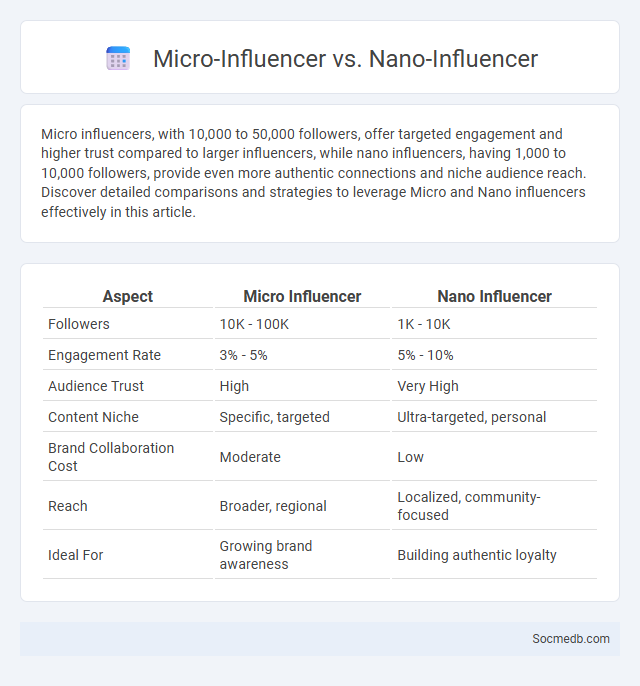
Photo illustration: Micro Influencer vs Nano Influencer
Micro influencers, with 10,000 to 50,000 followers, offer targeted engagement and higher trust compared to larger influencers, while nano influencers, having 1,000 to 10,000 followers, provide even more authentic connections and niche audience reach. Discover detailed comparisons and strategies to leverage Micro and Nano influencers effectively in this article.
Table of Comparison
| Aspect | Micro Influencer | Nano Influencer |
|---|---|---|
| Followers | 10K - 100K | 1K - 10K |
| Engagement Rate | 3% - 5% | 5% - 10% |
| Audience Trust | High | Very High |
| Content Niche | Specific, targeted | Ultra-targeted, personal |
| Brand Collaboration Cost | Moderate | Low |
| Reach | Broader, regional | Localized, community-focused |
| Ideal For | Growing brand awareness | Building authentic loyalty |
Defining Micro Influencers, Nano Influencers, and Influencers
Micro influencers typically have 10,000 to 100,000 followers, offering niche expertise and high engagement rates. Nano influencers possess fewer than 10,000 followers but deliver highly authentic connections and trusted recommendations within small communities. Influencers, broadly defined, are individuals who leverage their social media presence to impact audience behavior and brand perception; understanding these categories helps you tailor effective marketing strategies.
Follower Count: Key Differences
Follower count on social media platforms varies significantly depending on factors such as platform algorithms, content type, and audience engagement levels. Your follower count impacts your visibility, credibility, and potential for brand partnerships, making it crucial to understand these key differences across platforms like Instagram, Twitter, and TikTok. Accurate analysis of these metrics helps optimize growth strategies tailored to your target audience and platform nuances.
Engagement Rates Comparison
Engagement rates on social media vary significantly across platforms, with Instagram typically yielding higher interaction percentages than Facebook or Twitter due to its visual focus and user demographics. Influencer marketing campaigns show an average engagement rate of 1.5% to 3.5% on Instagram, compared to Facebook's 0.5% to 1% and Twitter's 0.2% to 0.9%. To maximize Your social media impact, concentrate on creating platform-specific content that encourages likes, comments, and shares to boost overall engagement rates effectively.
Content Quality and Authenticity
High-quality content on social media drives engagement by providing valuable, relevant, and well-crafted information tailored to target audiences. Authenticity builds trust and loyalty, as genuine posts and transparent communication foster meaningful connections between brands and users. Combining content quality with authenticity enhances brand reputation and boosts organic reach across platforms like Instagram, TikTok, and LinkedIn.
Audience Reach vs. Niche Targeting
Maximizing your social media strategy requires balancing audience reach and niche targeting to effectively engage potential customers. Broad audience reach increases brand visibility and drives traffic, while niche targeting enhances conversion rates by delivering personalized content to specific segments. Tailoring your approach based on data analytics ensures your message resonates with your intended audience, optimizing both growth and engagement metrics.
Cost and ROI Considerations
Evaluating social media marketing involves analyzing both cost efficiency and return on investment (ROI) to maximize budget allocation. Effective strategies measure metrics such as cost per click (CPC), conversion rates, and customer acquisition costs to ensure campaigns generate profitable engagement. Leveraging advanced analytics tools enables businesses to optimize spend and enhance revenue outcomes through targeted audience insights.
Brand Collaboration Opportunities
Social media platforms offer unparalleled brand collaboration opportunities by connecting Your business with influencers and target audiences instantly. Leveraging data-driven insights, brands can create tailored campaigns that boost engagement and drive conversions effectively. Strategic partnerships on social media amplify reach, enhance brand credibility, and maximize ROI through authentic content co-creation.
Impact on Purchase Decisions
Social media platforms influence purchase decisions by shaping consumer perceptions through targeted ads, user reviews, and influencer endorsements. Data shows that 74% of consumers rely on social media to guide their buying choices, with product recommendations on platforms like Instagram and TikTok driving significant sales increases. Brands leveraging social proof and personalized content on social media see higher engagement rates and improved conversion metrics.
Suitable Platforms for Each Type
Facebook excels for community building and targeted advertising due to its diverse user base and advanced analytics tools. Instagram thrives on visual content, making it ideal for brands focused on fashion, travel, and lifestyle with features like Stories and Reels. LinkedIn is the top platform for B2B marketing and professional networking, offering options for lead generation and industry-specific content dissemination.
Choosing the Right Influencer for Your Campaign
Selecting the ideal influencer for your social media campaign demands analyzing audience demographics, engagement rates, and content alignment with brand values. Researching micro-influencers with niche followings often yields higher authenticity and targeted reach, maximizing campaign ROI. Utilizing tools like social listening platforms and influencer marketing software enhances decision-making by providing data-driven insights on influencer performance and audience sentiment.
 socmedb.com
socmedb.com